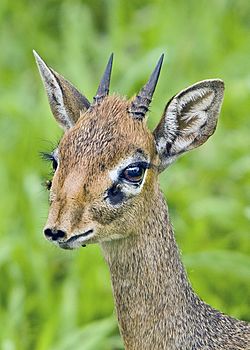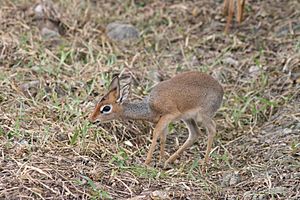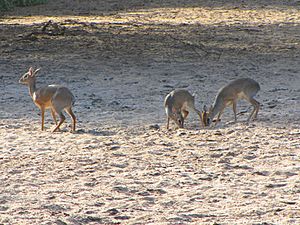Dik-dik facts for kids
Quick facts for kids Dik-dik |
|
|---|---|
 |
|
| A dik-dik | |
| Scientific classification | |
| Kingdom: | |
| Phylum: | |
| Class: | |
| Order: | |
| Family: | |
| Genus: |
Madoqua
(Ogilby, 1837)
|
A dik-dik is a very small antelope. It belongs to the genus Madoqua. These tiny animals live in the bushlands of eastern and southern Africa.
Dik-diks are quite small. They stand about 30–40 cm (12–16 in) tall at the shoulder. They are 50–70 cm (20–28 in) long. These antelopes weigh 3–6 kg (7–16 lb). Dik-diks can live for up to 10 years.
They get their name from the alarm calls of the females. When they sense danger, females make a "dik-dik" sound. Both males and females also make a high-pitched whistling sound. These calls can warn other animals about predators. The dik-dik is a favorite prey for the fast cheetah.
There are four different kinds of dik-diks:
- Günther's dik-dik (Madoqua guentheri)
- Kirk's dik-dik (Madoqua kirkii)
- Silver dik-dik (Madoqua piacentinii)
- Salt's dik-dik (Madoqua saltiana)
Contents
What Dik-Diks Look Like
Female dik-diks are a little bigger than males. Male dik-diks have small horns. These horns are about 3 in (8 cm) long. They slant backward and have grooves. The hair on top of their head forms a tuft. This tuft sometimes hides the male's short horns.
Their upper body is gray-brown. Their lower body, legs, belly, and sides are tan. Below each eye, they have a bare black spot. This spot holds a special preorbital gland. This gland makes a dark, sticky liquid. Dik-diks use this liquid to mark their territory. They rub grass or twigs into the gland to spread the scent.
How Dik-Diks Stay Cool
Dik-diks have long snouts with special muscles. These muscles help pump blood through their snout. Air flowing over the snout cools the blood. This helps them avoid getting too hot. This cooling method is mostly used in very hot weather. Dik-diks can handle temperatures up to 40 °C (104 °F).
Where Dik-Diks Live
Dik-diks live in the shrublands and savannas of eastern Africa. They look for habitats with lots of edible plants. Shrubs are a favorite food source. Dik-diks can live in thick forests or open plains. However, they always need good cover. They also prefer areas without too much tall grass.
They usually live in pairs. Each pair has a territory of about 5 hectares (12 acres). Their territories are often in low, bushy areas. These can be near dry, rocky streambeds. Dik-diks blend in well with their dusty brown coats. They have special paths or "runways" in their territory. They use these paths when they feel threatened.
What Dik-Diks Eat
Dik-diks are herbivores. This means they only eat plants. Their diet is mostly leaves, young shoots, fruit, and berries. They eat very little or no grass. They get enough water from their food. This means they do not need to drink water often.
Like all animals with even-toed hooves, they have four-chambered stomachs. Tiny living things in their stomachs help them digest food. After eating, they bring food back up to chew it again. This process is called 'chewing the cud'. Dik-diks have pointed heads. This helps them eat leaves from thorny acacia trees. They can eat while keeping their heads high. This helps them watch for predators.
Dik-Dik Families and Babies
Dik-diks usually stay with one partner for life. They are monogamous. Fights between dik-dik pairs are rare. When they do happen, the males charge at each other. They stop suddenly, nod their heads, and turn around. They repeat this, increasing the distance each time. One male will eventually stop.
Males mark their territory with piles of dung. They will cover the female's dung with their own. Staying with one partner might be safer for dik-diks. With many predators around, it is dangerous to look for new mates. Pairs spend about 64% of their time together. Males might try to mate with other females if they get a chance.
Baby Dik-Diks
Female dik-diks can have babies when they are six months old. Males are ready to mate at 12 months. The mother carries the baby for 169 to 174 days. She usually has one baby at a time. This can happen up to twice a year. It usually happens at the start and end of the rainy season.
Unlike other animals that chew cud, dik-dik babies are born differently. Their front legs are folded back along their body. Other babies are born with legs stretched forward. Female babies weigh about 560 to 680 g (1.2 to 1.5 lb) at birth. Male babies weigh 725 to 795 g (1.6 to 1.75 lb). The mother feeds her baby milk for six weeks. She feeds it for only a few minutes at a time. About half of young dik-diks survive.
Young dik-diks stay hidden after birth. But they grow very quickly. They reach their full size by seven months. At this age, the young must leave their parents' territory. Fathers chase away their sons. Mothers chase away their daughters.
Dik-Dik Predators
Dik-diks are hunted by many animals. Their main predators include leopards, caracals, lions, hyenas, wild dogs, and humans. Other animals that hunt dik-diks are monitor lizards, cheetahs, jackals, baboons, eagles, hawks, and pythons. Dik-diks have good eyesight to spot danger. They can also run very fast, up to 42 km/h (26 mi/h).
See also
 In Spanish: Dic-dic para niños
In Spanish: Dic-dic para niños




